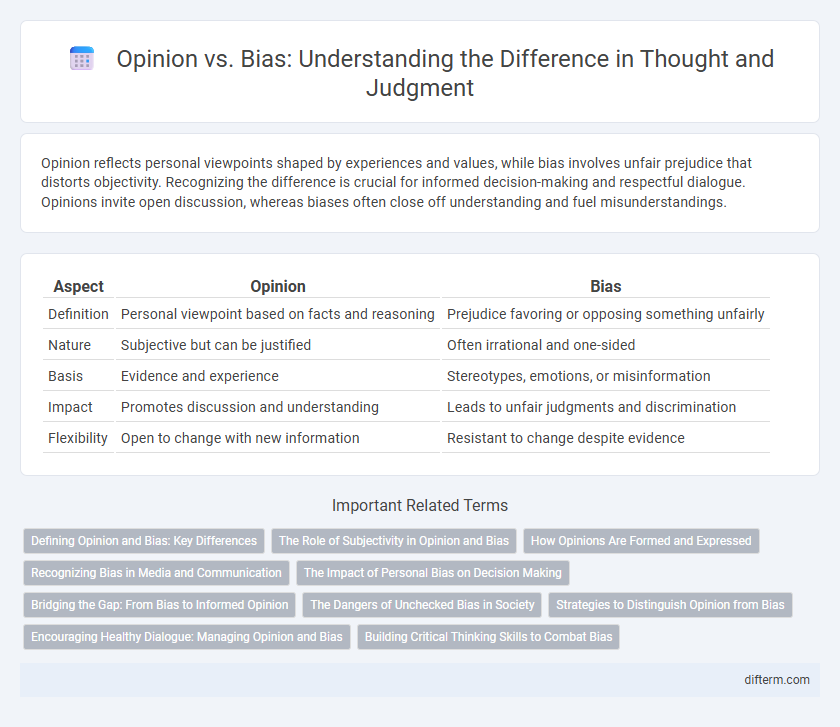Opinion reflects personal viewpoints shaped by experiences and values, while bias involves unfair prejudice that distorts objectivity. Recognizing the difference is crucial for informed decision-making and respectful dialogue. Opinions invite open discussion, whereas biases often close off understanding and fuel misunderstandings.
Table of Comparison
| Aspect | Opinion | Bias |
|---|---|---|
| Definition | Personal viewpoint based on facts and reasoning | Prejudice favoring or opposing something unfairly |
| Nature | Subjective but can be justified | Often irrational and one-sided |
| Basis | Evidence and experience | Stereotypes, emotions, or misinformation |
| Impact | Promotes discussion and understanding | Leads to unfair judgments and discrimination |
| Flexibility | Open to change with new information | Resistant to change despite evidence |
Defining Opinion and Bias: Key Differences
Opinion reflects a personal belief or judgment shaped by individual experiences and values, while bias involves a preconceived inclination that distorts impartiality. Opinions can be flexible and open to revision based on new information, whereas bias often leads to unfair favoritism or prejudice that resists change. Understanding this distinction is crucial for recognizing subjective perspectives versus unjust partiality in decision-making and communication.
The Role of Subjectivity in Opinion and Bias
Subjectivity plays a central role in shaping both opinion and bias, influencing perception and judgment based on personal experiences and emotions. Opinions reflect individual viewpoints that can evolve through reflection and evidence, while biases tend to be entrenched, often leading to unfair or prejudiced attitudes. Recognizing the subjective nature of opinions is crucial for distinguishing them from biases that skew reasoning and limit open-mindedness.
How Opinions Are Formed and Expressed
Opinions are formed through a combination of personal experiences, cultural influences, and information processing, allowing individuals to interpret facts and feelings uniquely. Expressed opinions reflect subjective viewpoints, shaped by reasoning and values rather than objective truths. Bias occurs when opinions are skewed by prejudice or selective information, limiting openness to alternative perspectives.
Recognizing Bias in Media and Communication
Recognizing bias in media and communication is essential for developing informed opinions and avoiding misinformation. Bias often manifests through selective presentation, language tone, and framing of facts, influencing audience perception. Critical analysis of sources, cross-referencing information, and awareness of one's own cognitive biases enhance the ability to distinguish objective reporting from subjective opinions.
The Impact of Personal Bias on Decision Making
Personal bias can significantly distort decision-making processes by filtering information through subjective perspectives rather than objective analysis. This influence often leads to selective attention, where individuals prioritize information that confirms pre-existing beliefs while disregarding contradictory evidence. Recognizing and mitigating personal biases is essential for enhancing critical thinking and achieving more balanced, informed decisions.
Bridging the Gap: From Bias to Informed Opinion
Bridging the gap from bias to informed opinion requires conscious effort to recognize and challenge personal prejudices by seeking diverse perspectives and credible sources. Developing critical thinking skills enables individuals to analyze information objectively, reducing the influence of confirmation bias. Cultivating an informed opinion promotes balanced understanding and constructive dialogue in decision-making processes.
The Dangers of Unchecked Bias in Society
Unchecked bias distorts judgment and undermines social cohesion by perpetuating misinformation and reinforcing stereotypes. This leads to polarization and systemic inequalities, as biased opinions often masquerade as objective truths, influencing policies and behavior negatively. Recognizing and challenging these biases is crucial to fostering a fair and inclusive society.
Strategies to Distinguish Opinion from Bias
Recognizing the difference between opinion and bias requires evaluating the presence of evidence and openness to opposing viewpoints; opinions are supported by reasoned arguments while biases often rely on preconceived notions. Critical thinking strategies like cross-referencing information and analyzing the intent behind statements help identify subjective opinions versus biased perspectives. Employing reflective questioning and seeking diverse sources enhances the ability to distinguish informed opinions from prejudiced biases in discourse.
Encouraging Healthy Dialogue: Managing Opinion and Bias
Encouraging healthy dialogue requires distinguishing between expressed opinions and underlying biases to foster mutual respect and understanding. Recognizing cognitive biases helps individuals critically evaluate their perspectives, reducing polarization and promoting constructive conversations. Cultivating open-mindedness and empathy strengthens the quality of discourse, enabling diverse viewpoints to coexist productively.
Building Critical Thinking Skills to Combat Bias
Developing critical thinking skills is essential for recognizing and overcoming bias in personal opinions. Critical thinking involves analyzing information objectively, questioning assumptions, and evaluating evidence to form balanced viewpoints. Cultivating these skills reduces the influence of cognitive biases, leading to more rational and unbiased decision-making.
opinion vs bias Infographic

 difterm.com
difterm.com